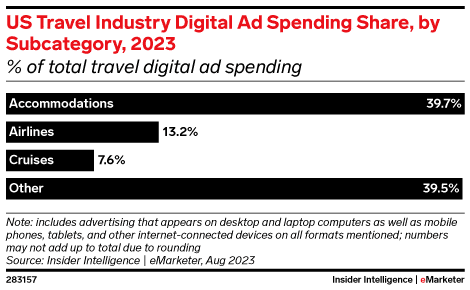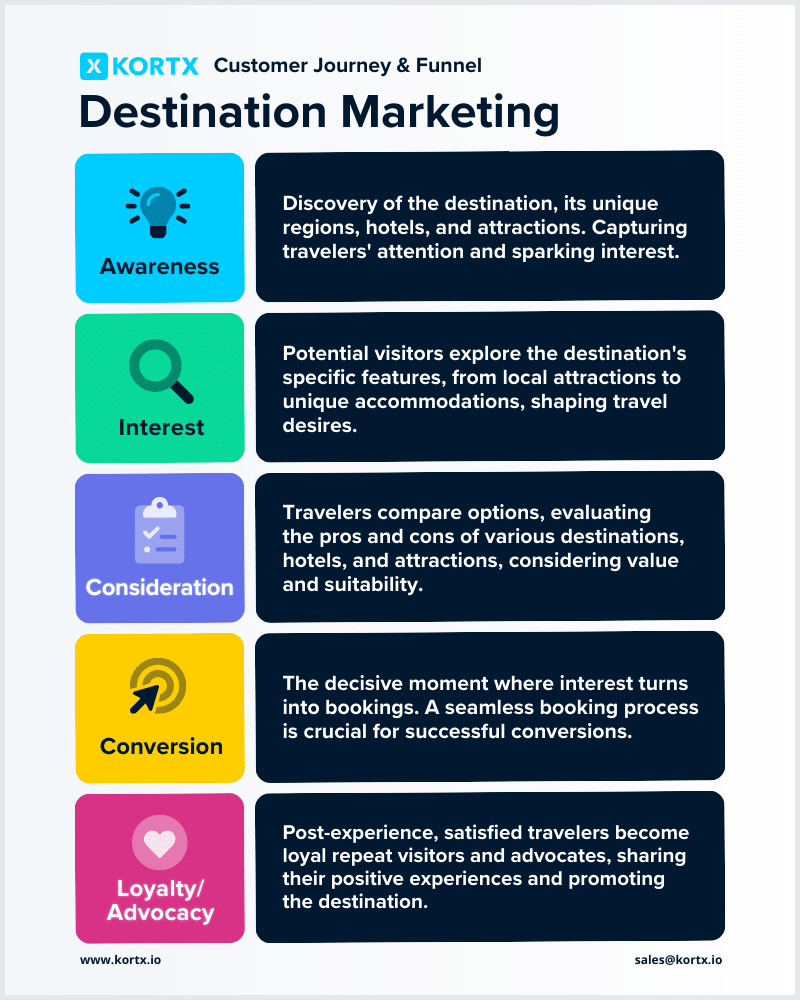Did you know a heavy reliance on Online Travel Agency (OTA) bookings such as Booking.com or Expedia can significantly limit your access to crucial marketing data? If the thought of being over-reliant on OTAs concerns you, you’re not alone.
The quest to attract travelers directly to your brand’s digital doorstep is more than a trend – it’s a necessity.
In this comprehensive guide to destination marketing, we cover the challenges and solutions of navigating the OTA-dominated landscape. This guide is packed with insights on how to reclaim control of your customer relationships, enhance direct booking profitability, and leverage your marketing data’s full potential.
What is Destination Marketing?
Destination marketing is a strategic marketing approach that promotes a specific location, such as a city, region, attraction, or hotel, to entice visitors and online bookings. This specialized form of marketing encompasses creating a compelling image of the destination, highlighting its unique interests, culture, and experiences.
Digital travel marketing leverages online platforms and technologies, such as a dedicated SEO-optimized website, social media, influencer partnerships, and targeted online advertising. Analytics plays a crucial role in understanding audience behavior and refining marketing efforts.
Destination marketing aims to increase awareness, inspire travel decisions, and boost tourism through strategic, creative, and data-driven digital campaigns.

Attracting the Right Travelers to Your Destination
To capture the attention and wallets of the right travelers, it’s imperative that you not only speak their language but also resonate with their unique travel aspirations.
Demographic Profiling, Behavioral Insights, and Interests
Demographic profiling is your goldmine in destination marketing. Understand who your travelers are, segmenting by age, income, geographic location, and even lifestyle. From there, dive deeper into behavioral insights—what are their buying habits? What inspires them to choose a destination?
Building out an audience persona for your ideal customer is incredibly helpful. This information will help you speak directly to them through your creative and discover where they spend their time online, what they stream, and how they prefer to book their travel.
Leveraging First-Party Data
First-Party data is an invaluable source of information. Analyzing data from your past and current visitors helps reveal patterns and preferences. For example, targeting similar demographics could lead to productive outcomes if you notice a significant number of visitors from a specific state or region. This data is also instrumental in creating accurate lookalike audiences. Leveraging First-Party data allows you to more effectively capture the attention and engagement of travelers most likely to be drawn to your destination.
How have you seen destination marketing trends evolve in the travel industry over the past few years?
“Back in 2017, all you needed was one stunning shot and a sentence or two to influence someone’s travel plans through social media. Today, there is so much content that cutting through the noise is more important than ever. Customers are now looking for authentic experiences from real people exploring on the ground – they crave genuine, unfiltered insights into the places they dream of visiting. This shift has led to a rise in storytelling, where travel bloggers and influencers share more in-depth narratives about their experiences. It’s not just about the visuals anymore; it’s about connecting with an audience through personal stories and practical tips that give a true sense of the destination.”

Inspired by Croatia
Customer Journey Stages in Destination Marketing
Understanding the customer journey from initial awareness to post-experience advocacy is crucial. Each stage is pivotal in transforming potential visitors into real-world bookings and future loyal advocates for a destination.

Awareness
In this initial stage, travelers learn about a destination, including its unique regions, hotels, and attractions. It’s about capturing the travelers’ attention and planting the seed of interest.
Interest
At this stage, potential visitors delve deeper into what the destination offers. They explore specific aspects, such as the distinctive features of accommodations or the experiences provided by local attractions, shaping their travel desires.
Consideration
Travelers now compare their options, weighing the benefits and drawbacks of different destinations, hotels, and attractions. This stage involves thoughtful contemplation about what each choice offers regarding value, experience, and suitability.
Conversion
The critical decision-making point is where interest turns into action. Travelers finalize their choices and make bookings. Ensuring a seamless and straightforward booking process is vital to successful business conversions.
Loyalty/Advocacy
Post-experience, satisfied travelers can become repeat visitors (loyal) and act as advocates, sharing their positive experiences with others and indirectly promoting the destination, hotel, or attraction through word-of-mouth or social media. This stage is essential for building a sustainable visitor base and enhancing brand reputation.
Authenticity Over Glossy Photoshoots
“A core content problem the travel industry faces today is authenticity. Whereas glossy images that painted a picture of perfection once ruled the tourism landscape, the industry has been going through a reckoning. Consumers no longer want that fabricated, sanitized scenery. They want to interact with residents and participate in experiences, events, and activities that are unique to this space and place.
This reckoning offers an incredible opportunity for businesses to impact messaging for their destination. Through quality travel content marketing that includes diverse representation, local storytellers, and an environmental focus, individuals within the travel industry can change the entire landscape.”

Destination Marketing Recommended Marketing Channels
Effective destination marketing requires a strategic approach tailored to different customer journey stages across marketing channels. Explore recommended marketing channels for each funnel stage, ensuring a comprehensive and impactful outreach to potential travelers.
Awareness Stage
At this initial stage, it’s all about capturing the attention of potential visitors and making them aware of your destination. The channels recommended here are geared towards broad reach and generating interest:
- Display Advertising: Utilize visually engaging ads to capture the attention of a broad audience. This channel is ideal for showcasing the allure of your destination, whether it’s a city, region, hotel, or specific attraction.
- Social Media Marketing: Platforms like Instagram and Facebook are perfect for sharing captivating visuals and stories about your destination. Use these platforms for interactive engagement, building a community around your brand.
- Connected TV (CTV): Leverage streaming platforms to reach audiences with targeted ads. This is especially effective given the growing trend of streaming media consumption.
Interest Stage
During the interest stage, potential visitors delve deeper into the specifics of a destination or location. The channels here focus on providing detailed information and engaging content:
- SEO and Paid Search: Optimize your content for search engines and use paid search strategies to target audiences actively seeking travel experiences. This ensures your destination is easily discoverable by interested travelers.
- Display Advertising: Once future visitors have expressed interest in your location or destination, showcase personalized options through display advertising.
Consideration Stage
At the consideration stage, travelers compare options. The channels here should provide deeper insights and comparisons to aid in their decision-making:
- Digital Out of Home (DOOH) Advertising: Use dynamic digital advertising in strategic locations to capture the attention of travelers, providing them with compelling reasons to choose your destination over others.
- Local SEO Tactics: Implement strategies to improve visibility in search results for travelers considering multiple destinations, making it easier for them to find and choose yours.
Conversion Stage
This critical stage is where interest turns into action—bookings. Channels here should facilitate a smooth booking experience:
- Direct Booking Platforms: Encourage direct bookings using your website or app, offering a seamless and straightforward booking process. This not only increases profitability but also strengthens direct relationships with customers.
- Retargeting Ads: Use retargeting strategies to remind those who have shown interest in your destination but haven’t booked yet, nudging them toward making a reservation.
Loyalty/Advocacy Stage
After the travel experience, it’s crucial to turn satisfied travelers into repeat visitors and advocates:
- Social Media Engagement: Engage with visitors post-experience on platforms like Instagram and Twitter. Encourage them to share their experiences and use specific hashtags to broaden their reach.
- Customer Feedback and Review Platforms: Encourage visitors to leave reviews and share their experiences on platforms like TripAdvisor, enhancing your destination’s reputation and attracting future visitors.
Enhancing Destination Marketing with Retargeting Strategies
Retargeting is a crucial tool in destination marketing, serving as a bridge across various customer journey stages. This overview highlights critical retargeting strategies:
- Utilize First-Party Data: Leverage data from digital interactions for targeted campaigns, ensuring personalized and relevant ads.
- Cross-Channel Retargeting: Implement retargeting across diverse digital channels like Display, Rich Media, Audio, and CTV for broader reach.
- Personalization and Segmentation: Tailor ads based on user interests and previous interactions, enhancing engagement and conversion potential.
- Optimize Timing and Frequency: Time your ads strategically and manage frequency to maintain relevance and avoid ad fatigue.
- Focus on Conversion & Loyalty: Use retargeting to encourage bookings and foster post-visit loyalty, offering repeat visits and referral incentives.
Incorporating these strategies can significantly boost the effectiveness of your destination marketing efforts, converting interest into bookings and building lasting customer relationships.
Attraction/Points of Interest Marketing
Marketing specific attractions and activities is one of the more long-term tourism funnels. Travelers who are planners will likely do their research in advance and even purchase entrance tickets and passes, including deals across multiple attractions. Others wait until they arrive at their vacation or travel destination to choose activities.

How to Market Points of Interest
- Planning Timeline: Attractions must strategize their communication to appeal to long-term planners and spontaneous tourists. Market the perks of early planning for grand attractions that often require advance reservations. Conversely, day attractions should capitalize on impromptu decision-making with messages of immediacy and convenience.
- Booking Preferences: While maintaining the traditional in-person booking option, attractions should heavily promote online booking. Offer online-exclusive incentives such as discounts and fast-track entry options, steering customers toward a more efficient, measurable, and data-rich booking process.
- When to Capture Your Customer: Advertise throughout their travel planning as well as during their stay. This will help capture planners and spontaneous visitors.
- KPIs to Track: Specific KPIs measure success in attraction marketing:
- Online Bookings: Scrutinize online booking rates to gauge the effectiveness of digital strategies.
- Website Traffic & Activity: Analyze website traffic for visitor interest.
- Foot-Traffic: Monitor foot traffic for real-world impact.
- Brand Awareness: Measure impressions to assess brand reach and recognition.
Hospitality (Hotels & Accommodations) Digital Marketing
In 2023, travel often begins online, and the hospitality sector—encompassing hotels and accommodations—plays a pivotal role in shaping a traveler’s journey. From the moment a traveler starts planning their trip, the choice of accommodation stands as a critical decision, influencing the trajectory of their entire travel experience. This section explores the nuances of hospitality marketing, underscoring the importance of understanding and adapting to evolving online booking preferences and effective customer engagement strategies in a digitally connected world.

How to Market Hotels & Accommodations
- Planning Timeline: Choosing a hotel or accommodation is often one of the initial decisions in travel planning, highlighting the crucial role of the hospitality industry in the overall travel experience. It typically ranks as the first or second choice for travelers, alongside selecting a region or location. This emphasizes the importance of a strategic marketing approach that caters to both advance planners and last-minute decision-makers.
- Booking Preferences: The preference for online bookings is significant, with 72% of Americans opting to make travel arrangements online, underlining the need for hotels and other accommodations to maintain a robust and visible online presence. The trend towards online bookings demands that hotels enhance their digital booking experiences. Online Travel Agencies (OTAs) are a popular choice, with 41% of Americans using them for bookings. Yet, direct bookings are equally important, as 29% of travelers book directly with hotels, the same percentage that relies on travel agents or tour operators.
- When to Capture Your Customer: The optimal time to engage potential visitors is during the awareness and planning stages with campaigns that highlight the amenities and unique features of the hotel. Capture audiences interested in your particular region location and the general culture and environment surrounding your accommodation. For example, a beachfront hotel in the Outer Banks of North Carolina would want to reach audiences interested in visiting the Carolinas and those who want a beach vacation without any region in mind.
- KPIs to Track: Key performance indicators for effective marketing include:
- Site Visits & Online Bookings: Reflecting the success of digital engagement and conversion efforts.
- Brand Visibility and Local SEO: Indicating how prominently the hotel features in online searches, especially for location-based queries.
State & Regional Tourism Marketing
State and regional marketing captures meticulous planners and spur-of-the-moment tourists, engaging potential travelers at the outset of their journey planning. Whether it’s the allure of unfamiliar cities or the charm of scenic regions, the marketing strategies here lay the foundation for travelers’ choices, with preferences often swayed by factors like pricing and the time required for the trip.

How to Market Regional Destinations
- Planning Timeline: Engaging with travelers at the beginning of their trip-planning process is crucial. For states and regions, this means deploying marketing strategies catering to long-term planners and those making last-minute decisions.
- Booking Preferences: The marketing approach should be adaptable, highlighting the convenience and comprehensive offerings of the state or region to cater to various booking preferences.
- When to Capture Your Customer: The optimal time to engage potential visitors is during the awareness stage with campaigns that inform and inspire travelers about the state or region’s offerings.
- KPIs to Track: Measure the success of regional/state marketing through:
- Website Traffic: The influx of visitors to tourism sites offers insights into interest levels.
- Brand Awareness/Impressions: Understanding how well the state or region’s branding resonates with the target audience is critical to refining marketing strategies.
- Tourism Statistics: Track any uptick in travel to your state or region following campaigns.
Destination Marketing Organization (DMO) Strategies
Destination Marketing Organizations (DMOs) play an integral role in shaping the tourism landscape, combining strategic marketing initiatives encompassing regions, attractions, and accommodations. They are responsible for crafting a compelling, cohesive destination image, appealing to a broad spectrum of travelers, from meticulous planners to spontaneous adventurers.

DMO Marketing Plan
- Planning Timeline: DMOs must balance their strategies to attract long-term planners and impromptu tourists. This involves promoting the benefits of early planning for major attractions requiring reservations while highlighting spontaneous experiences’ appeal for more flexible travelers.
- Booking Preferences: DMOs should encourage online booking processes by offering exclusive online incentives like discounts or special access through partnerships with local attractions and accommodations. This approach caters to the growing preference for digital transactions and enables better tracking and data collection, enhancing future marketing efforts.
- When to Capture Your Customer: The best moment for engaging prospective visitors is in the awareness phase, using campaigns that educate and excite them about the state or region’s attractions.
- KPIs to Track: Key performance indicators for DMOs include:
- Online Booking Rates: To assess the effectiveness of digital booking strategies.
- Website Traffic: As a measure of interest in the destination.
- Foot Traffic Data/Tourism Stats: To gauge the real-world impact of marketing campaigns.
- Brand Impressions: To understand the reach and recognition of the destination’s brand.
What emerging trends or technologies will significantly impact tourism marketing in the next few years?
“The rise of data dashboards that grant DMO leaders access to vast amounts of comprehensive data in one place is noteworthy. However, interpreting this information poses a challenge. Anticipating technological strides, especially with AI advancements, suggests a shift towards understanding how all the varying data sets work together.”

Online Travel Agencies: Understanding Their Role and Reach
Online Travel Agencies (OTAs) like Booking.com and Expedia have become go-to platforms for many travelers, especially those making last-minute plans or seeking budget-friendly options. They offer a convenient one-stop shop for comparing prices and availability, making them popular (41% of travelers prefer an OTA).
The Cost of Using OTAs
There are trade-offs to using OTAs. When customers book through these platforms, businesses lose valuable data and a significant portion of revenue to commission fees. Direct bookings through a company’s website or a dedicated app are more profitable and provide richer customer data. This information is vital for personalized marketing and improving the customer experience.
OTAs in the Research Phase
It’s important to remember that OTAs are often used for research purposes, even by customers who prefer direct bookings. For example, a traveler loyal to a specific airline might use OTA sites to track flight pricing trends before purchasing directly from the airline’s app. Similarly, travelers often browse OTAs to explore accommodation options but ultimately book now with the hotel or use credit card rewards programs for added security and benefits.
Guiding Customers to Direct Booking
While it’s beneficial to maintain a presence on OTAs for visibility and to capture a specific customer segment, businesses should strategically guide customers toward direct booking channels. CTAs on websites and marketing materials should ideally lead to the business’s booking system rather than an OTA. This approach not only increases profitability but also strengthens direct relationships with customers.

Beyond Neighboring States: Expanding Your Reach
Expanding your market reach beyond neighboring states requires a data-driven approach to identify untapped markets. Instead of solely focusing on geographical proximity, dive into visitor data to uncover trends and new potential markets, including international audiences. Critical strategies include leveraging data to understand broader market trends, accommodating various transportation preferences, and customizing international marketing efforts.
Utilizing Data for Market Expansion
Analyze visitor data comprehensively to pinpoint emerging interest from non-adjacent regions or overseas. This insight allows for more targeted marketing, aligning with the interests and preferences of these newfound audiences.
Accessibility & Transportation Factors
Travelers prefer different transportation modes – road, air, rail, or bus. Understanding these preferences through data can guide partnerships with travel companies, fostering attractive travel packages and improving accessibility to your destination. How tourists and visitors arrive at your location can also help you gather more info. For example, if most visitors check out your museum drive rather than fly, DOOH billboards along the highway will be far more effective than those in the airport.
International Marketing Insights
Consider cultural, linguistic, and travel behavior differences when targeting international markets. Adapt marketing materials to resonate with these audiences and stay informed about visa and travel policies that may affect them.
📱 🖥️ 📺
Try KORTX Intelligence Audience Discovery
Our expert strategists analyze your brand, audience, and competition, delivering data-driven recommendations that outperform generic tools.
Gain actionable insights, audience attributes, and sure-to-be-successful strategies.
Measuring the Success of Your Destination Marketing Efforts
Accurately measuring the effectiveness of your destination marketing efforts is crucial in understanding the impact of your strategies and making informed decisions for future campaigns. Key performance indicators (KPIs) play a vital role in this evaluation process, providing quantifiable metrics that reflect the success of various marketing initiatives across the customer journey.
Comprehensive Tracking with Key Performance Indicators
Tracking a range of KPIs throughout the marketing funnel is essential to gain a holistic view of your marketing effectiveness.
These include:
- Website Traffic and Online Bookings: These KPIs are fundamental in assessing digital engagement and conversion rates. Tracking online bookings is especially critical. Direct bookings save on commission fees and provide richer customer data.
- Foot-Traffic & Location-Based Effectiveness: Monitoring foot traffic for physical destinations and attractions helps gauge the real-world impact of marketing efforts. Location-based marketing effectiveness can be measured through geotagging and location analytics.
- Brand Visibility & Local SEO: These metrics indicate how effectively your destination is being marketed online, especially in local and regional searches.
- Social Media Engagement: Analyzing interactions on social platforms can provide insights into brand reach and audience sentiment.
The Importance of Direct Booking Channels
Prioritizing direct booking channels in your marketing CTAs is essential. Direct bookings through your website or app increase profitability and provide valuable data for refining your marketing strategies and understanding customer preferences.
Unlocking Data-Driven Success for Your Destination
Successful destination promotion is as dynamic as the destinations themselves. By embracing innovative strategies, understanding the diverse needs of travelers, and leveraging the power of data-driven insights, you can create compelling, memorable experiences that attract and retain a loyal and enthusiastic visitor base.
About the Author
Erik Stubenvoll is a Managing Director at KORTX with over 20 years of experience. When he is not learning about his client’s goals, he is on the sidelines with his wife at his daughter’s softball and soccer games or on the golf course.

